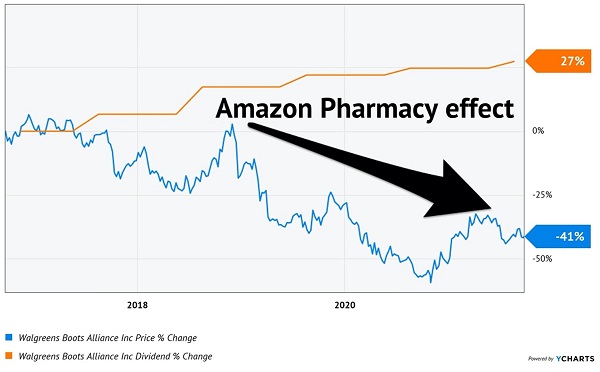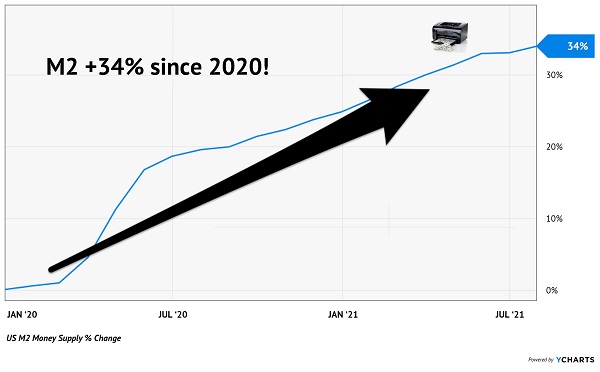The stock market goes up as well as down and, for whatever reason, it tends to swing wildly in September and October. With last Monday’s intraday price action, we saw our first 5% decline in a year.
The last time the S&P 500 fell by 5% or more was… this time last year.
Losing money isn’t fun. Then again, it is our job to make sure that paper losses stay on the page.
Historically speaking, this is a good month to go shopping. Last October, we locked in 7.3% to 10% dividends—and 51% total returns (in just 12 months!) soon followed. November kicks off the “seasonally strong” portion of the calendar, which means this is often last call for the bargain bin.
But we must differentiate between:
- A stock that is selling off for no reason, and
- A stock that is selling off for good reason.
“Because it’s October” would qualify as no reason. And “credit contagion” concerns about a Chinese property developer are a stretch to have any relevance to our income holdings.
A good reason, meanwhile, could be a dividend that is due to come under pressure. Or a business model that is about to become obsolete because Amazon.com (AMZN) is tackling the niche.
For example, we received an Amazon Pharmacy flyer in the mail last week. I picked it up, placed it next to one of our many unopened Amazon packages, and said a quick eulogy for Walgreens Boots Alliance (WBA).
Walgreens, we do appreciate your dividend growth. But Mr. and Ms. Market have been sniffing around your expiring business model for years. It’s time to innovate or die, and I’m afraid it’s time to tee up Axl Rose to pronounce the latter:
Call a Doctor: When Div Growth Doesn’t Matter

Pay attention to pullbacks, as Mr. and Ms. Market do tend to “tip their hands.” September was ugly, but it was noteworthy that the 10-year rate did not tank. When stocks swoon, rates usually head lower because investors pile money into bonds for safety.
The lack of downside action was a precursor to an upside breakout in interest rates. Our dividend paying bank stocks went bonkers. Comerica (CMA), a rising rate winner we’ve discussed all year long in these pages, soared 4.9% last Wednesday. Contrarian Income Report readers have now enjoyed 36% total returns with CMA since our January recommendation, and the gains could really accelerate if rates pop.
So, the breakdown in Walgreens was legitimate. There was no reason to own this stock before the pullback anyway, but if you still do, it really is time to consider selling.
Comerica’s dip, meanwhile, was a buying opportunity. These two stocks had similar price action during the September pullback, but their underlying business prospects are heading in opposite directions. Avoid the loser and buy the winner.
Stock investing is nuanced. Each company requires its own separate analysis. A simple dividend chart isn’t enough, as we see in the case of Walgreens.
Bond buying is easier. In Bondland, we have only two types of risks:
- Duration risk, and
- Credit risk.
Duration risk is the threat of interest rates rising while we “endure” the remaining life of the bond. As rates rise, fixed-rate payers lose value. The shorter the duration, or obligation to stay in the bond, the less the risk. Bond buyers can “reset” their coupon rates higher, sooner.
Low-paying Treasuries and fixed income ETFs have a duration risk that, in my opinion, outweighs their yields. At 1% or 2%, they pay so little—and lock in our money for so long—that they’re not worth it.
High-paying CEFs (closed-end funds), on the other hand, pay enough extra yield to buffer themselves from higher rates. If the 10-year rate rose to 2%, bond funds paying, say, 5% or 6% or more should be fine.
Plus, expert bond shops like DoubleLine are smart enough to shorten their duration when rising rates are on the table. DoubleLine Income Solutions Fund (DSL), for example, now has an average weighted duration of under three years. This is an extremely low duration for a fund like DSL, an excellent adjustment from a top-notch management team. It gives its manager—“bond god” Jeffrey Gundlach—the freedom to hedge his fixed income holdings from higher rates.
Duration risk can be managed—how about credit risk? Aberdeen’s Asia-Pacific Income Fund (FAX) has been on the receiving end of China-debt-default hysteria. But you wouldn’t know it by looking at the fund’s net asset value (NAV), or the value of its bonds, which has barely budged over the past month:
NAV Steady, Price-Only Pullback

Its price, on the other hand, has been punished while armchair market observers learn about Evergrande and the Chinese credit markets for the first time. When discount windows widen in CEFland due to a short-term price panic, they usually represent short-term buying opportunities.
Perceived risk is not actual risk, however, and these headline sellers are overreacting. FAX’s Chinese credit risk is being overblown by rookies to the Asia debt markets.
As contrarian investors this presents an opportunity for us. We shouldn’t wait too long to take advantage of this, though. As soon as the world forgets about Evergrande, this timely discount is likely to disappear.
Again, this is the time to go dividend shopping. Sure, stocks are pricey by traditional measures. But the Federal Reserve has printed a ton of money, increasing the existing M2 money supply by more than one-third since the start of 2020:
Print, Baby, Print

This money is flooding the capital markets and boosting stock and bond prices. It’s the reason why the S&P 500 never seems to correct for more than a few weeks before it’s off to the races again.
This is a good ol’ fashioned “Fed-fueled” dividend rally that is showing no signs of stopping. Jay Powell’s printing press has unlocked a series of income investment opportunities that we may never see again. Click here and I’ll share the details on 7 “Fed-fueled” stocks to buy right now.

Recent Comments